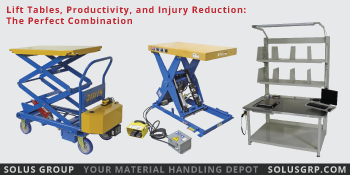We use cookies to make your experience better. To comply with the new e-Privacy directive, we need to ask for your consent to set the cookies. Learn more.
Lift Tables, Productivity, and Injury Reduction: The Perfect Combination
A strategically placed lift table can help any warehouse improve productivity while reducing staff injuries. This simple ergonomic solution allows a heavy-duty machine to do the lifting instead of your valuable staff.
It's no secret that musculoskeletal disorders make up a large chunk of all workplace injuries. The CDC recommends using both administrative and engineering approaches to improve ergonomics during material handling tasks to avoid these types of problems. Here are a few ways the experts tell us to do just that:

Schedule Wisely for Administrative Improvements
Administrative solutions for ergonomics start with smart scheduling to minimize workers' risk of repetitive motion injuries. Some examples of these administrative improvements to the workplace could include:
- Providing short breaks to allow muscles to recover.
- Alternating tasks so that one part of the body is not overused.
- Adjusting schedules so heavy and light tasks are mixed through the day.
The goals of administrative and engineering improvements are the same. Namely, they are to:
- Reduce bending and reaching.
- Reduce the force and energy required to complete the task.
- Reduce stress on back and shoulders.
Many of these improvements involve job rotation. You can assign an employee to unpacking tasks early in the day and shift them to the shipping and receiving desk later in the day. While rotating jobs is ideal in theory, practical roadblocks can make implementation difficult.
For example, operations with smaller staffs may not have the manpower to allow alternating tasks. Some workers will not be suited to every task, which means that they cannot participate in the rotation.
In these instances, warehouse managers can turn to engineering solutions to improve ergonomics.
Using Lift Tables for Engineering Improvements
Carefully observing your operation's workflow can inform you of possible improvements. Are there bottlenecks, high error rates, or frequent complaints of injuries in certain areas of the warehouse? These could be signs that improvements are needed at a structural level.
If more training or administrative improvements don't increase your productivity, consider investing in powered machines, like lift tables. A heavy-duty lift table will check off all of the boxes in improving ergonomics.
Lift tables reduce the need for bending and reaching by bringing loads to the desired height. They reduce the effort needed to complete tasks by allowing staff to slide loads laterally instead of raising and lowering them. Both of these improvements help to reduce strain on the back and shoulders of staff.
You can further improve productivity and reduce error rates by investing in the appropriate lift table top. Options such as a roller conveyor or ball transfer can prevent bottlenecks by speeding up packing and unpacking.
A mobile lift table allows staff to effortlessly wheel an ergonomic device to any part of the warehouse to make work safer. With this option, staff won't have to decide whether or not to risk lifting an overly heavy load.
You don't always need bigger, better equipment to outperform your competitors. Making commonsense administrative changes can yield big results.
At the same time, giving your staff heavy-duty, state-of-the-art lift tables to do their grunt work can improve morale and productivity while keeping injuries to an absolute minimum. Now, that's a winning combination.
References:
"Ergonomic Guidelines for Manual Material Handling." CDC. The National Institute for Occupational Safety and Health, Centers for Disease Control and Prevention, 2007. PDF. 18 May 2017.
"Prevention of Musculoskeletal Disorders in the Workplace." OSHA. Occupational Safety and Health Administration, United States Department of Labor, n.d. Web. 18 May 2017.
